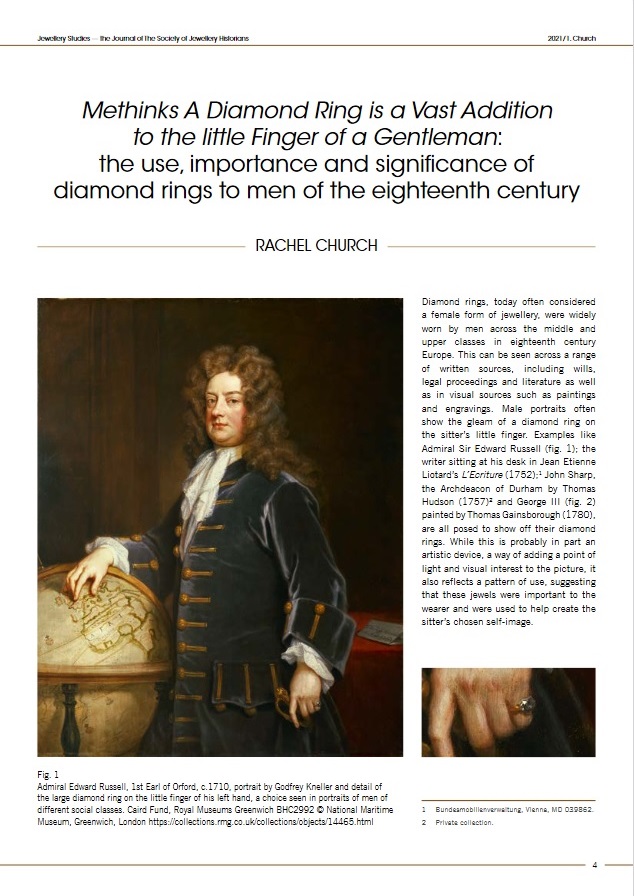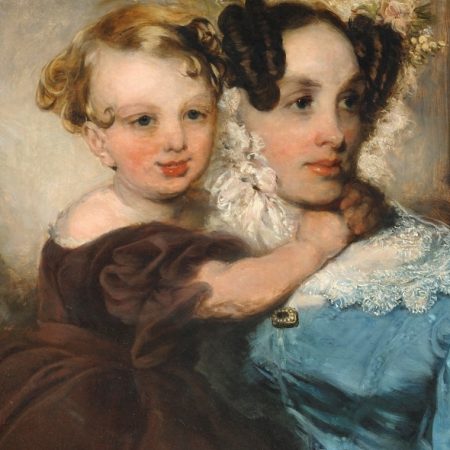‘”Methinks a Diamond Ring is a Vast Addition to the little Finger of a Gentleman”: the use, importance and significance of diamond rings to men of the eighteenth century’ by Rachel Church

The basis of this article was a paper given at the Society of Jewellery Historians conference Jewels in Portraits: Portraits in Jewels (June 2019) and updated in the Understanding British Portraits network Annual Seminar 2019. It looks at the significance of jewellery in male portraits across the eighteenth century with a particular focus on diamond rings.
Although European eighteenth century male portraits show restraint in the use of jewellery, the sparkle of a diamond ring can sometimes be seen on the little finger of one hand. Diamonds were prized for their expense, rarity and luminous qualities but diamond rings also had a particular importance for men. They were signifiers of gentility, part of the dress and jewellery which marked a gentleman. Conversely, this role was exploited by fraudsters and deceivers – wearing a diamond ring could give a spurious impression of respectability and wealth, a tension exploited in contemporary plays and poetry.
Diamond rings were also praised for their ability to set off a shapely, white hand – in itself a sign of gentility. In a 1760 play by Mrs Centlivre, the servant Lissardo, wearing his master’s diamond ring, is comically transformed: ‘methinks I have a very pretty Hand – and very white – and the Shape! […] In my Opinion, it is a very fine shap’d Hand and becomes a Diamond Ring, as well as the first Grandee’s in Portugal’.
These rings were made to be displayed and admired. As the Spectator claimed of the auctioneer James Christie ‘the displaying of a fine Brilliant glittering on the little Finger […] adds an irresistible Force to whatever you deliver, gives it the Stamp of Sterling Wit and makes it pass current’.
A diamond ring was also a gift of political patronage or appreciation. Bringing the news of General von Laudon’s victorious storming of Schweidnitz in 1761 earned the messenger a diamond ring from the Empress Maria Theresa and rings were given to actors, inventors, ambassadors and musicians. Diamond rings were therefore used to signal status and taste and also as the reward for social, political and artistic achievements.
The range of uses of these rings and the importance attributed to them means that they were indeed ‘a vast addition to the little finger of a gentleman’.
Download the paper from Jewellery Studies. The Journal of The Society of Jewellery Historians (2021/1) by Rachel Church, curator in the Sculpture, Metalwork, Ceramics and Glass Department, V&A Museum: Rachel Church, Jewellery Studies, 2021/1 (PDF)
Bio: Rachel Church is a curator in the Sculpture, Metalwork, Ceramics and Glass Department at the Victoria and Albert Museum. She was part of the team which redisplayed the William and Judith Bollinger Jewellery Gallery in 2009 (refreshed in 2019). She has written and lectured broadly on jewellery, on gold boxes in The Gilbert Collection at the V&A (ed. Timothy Schroder, 2009) and is the author of Rings (V&A/ Thames and Hudson 2011, updated 2017) and Brooches and badges (V&A/ Thames and Hudson 2019). She is currently researching men’s use of jewellery.

